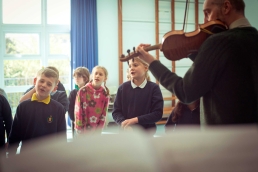Cerdd Iaith and ‘Tango’r Tengo’ – Cerdd Iaith is for everyone!

Take a look at blogs 1 and 2 to get an introduction to the British Council’s Cerdd Iaith resources. In this blog, we’re exploring some more aspects of this resource.
So, let’s take a look at the song ‘Tango’r Tengo’ which is an integral part of the Cerdd Iaith resource. The aim of this song is to introduce learners to the idea that some phrases don’t translate exactly. To help them understand this we encourage the learner to listen deeply and to try different melodies and languages simultaneously. The Tango is traditionally a very emotional dance, so again it’s important for learners to engage their whole bodies and to see what expressive dance moves they can come up with!
Another important aspect of Cerdd Iaith, and in many ways the most important, is that the teacher gets to try new things, to break with the normal routines of a lesson and get funky! This means that things will go wrong, it’s inevitable, perhaps especially if the teacher isn’t a linguist, but this doesn’t matter because mistakes are the best way to learn! Creative language learning is as much about embedding an ethos, that it’s ok to make mistakes, into language lessons, as anything else.
We know that many countries around the world use nursery rhymes to entertain and to teach learners about the world and as Professor Susan Holland explains in her book The Power of Music:
There is now a substantial body of evidence to suggest that engagement with music plays a major role in developing oral perceptual processing patterns while facilitating coding and identification of speech sounds and patterns.
Integrating drama games and song into the learning process for international languages is not new. What goes one step further is the concentration on encouraging teachers to use the sound qualities of the languages themselves, the essential muscularity and musicality of the language to help learners to find where the language sits in their minds, imaginations, and bodies.
As Dr Jessica Mordsley, who evaluated the initial pilot of Cerdd Iaith, points out in her blog, ‘Why use rhythm and rhyme and repetition in a Language Learning class?’:
Musicians convey language patterns more easily than non-musicians, and there are parallels between the skills the musicians and linguists need – for example, the ability to identify and create specific sounds, to segment sound patterns, (i.e. divide them into smaller unit of sound) and the need to develop sophisticated aural memory and perception.
Dr Mordsley goes on to say:
Every spoken language has its own ‘prosody’ – the characteristic patterns of stress, intonation, and rhythm. Unlike English, in both Welsh and Spanish, the stress usually falls on the penultimate syllable of a word (although this varies according to the position of the word in the phrase). Some primary schools have been teaching English, Welsh, and Spanish at the same time… (using the Cerdd Iaith resources) this helps to train the learners’ ears to hear the characteristic rhythms and melodies of the three languages.
For example, in Cerdd Iaith, the first exercise simply introduces single words in English, Spanish, Welsh, and German. Each syllable of each word has a musical tone and rhythm, it is already a small unit of music. When you add to this a series of images that the word represents, you are appealing to the child’s imagination, using that word and what it can represent. When you ask the child to create that word or picture with their bodies, the learning becomes physical and embodied.
It cannot be stated strongly enough that Cerdd Iaith was created to support non-specialist language teachers, it requires teachers to only be one step ahead of their learners, or even to be co-creating language learning as they progress through the exercises. However, to be clear, we are not advocating that there is a magic pill for learning a language. Malcolm Gladwell’s 10,000 hours theory holds as true to languages as most other things and achieving proficiency in a new language requires months and years of hard work. However, Cerdd Iaith is aimed at Primary School teachers and is first and foremost a tool to encourage the fun and creativity in language learning in the hope that learners will carry this enjoyment forward, progressing to secondary school with the idea that languages can be fun and creative.
So, why not give it a go with your learners, and see where Cerdd Iaith takes you?
Note: The British Council developed the Cerdd Iaith resource with colleagues from BBC National Orchestra of Wales, Yr Athrofa – the Institute of Education (UWTSD) and Ein Rhanbarth ar Waith (ERW), with the help of the Paul Hamlyn Foundation’s Teacher Development Fund. We hope you enjoy using it and would love to hear what you think. If you have any questions please get in touch at TeamWales@britishcouncil.org and please visit the Cerdd Iaith website here.
